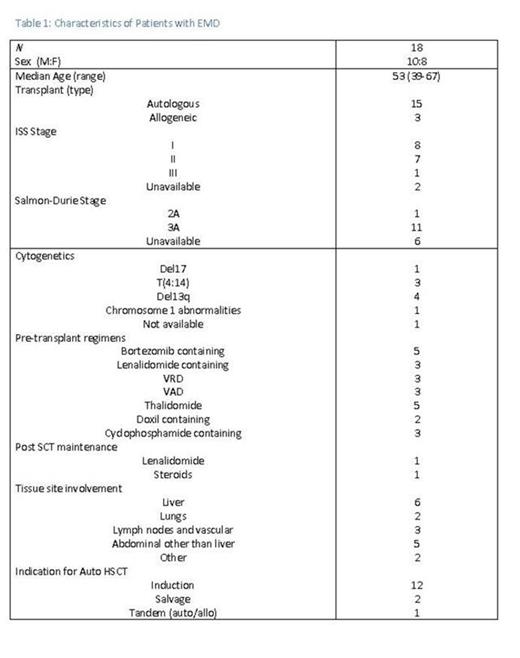Abstract
Multiple Myeloma (MM) is an incurable neoplasm, however recent advancements in therapies have led to median overall survival of 7-10 years in standard risk patients. High risk patients still succumb to the disease within 3 to 5 years. Traditionally used clinical prognostic markers such as the International Staging System (ISS), the Durie-Salmon (DS) staging system, and cytogenetics do not adequately predict response to novel agents or overall prognosis. We previously presented data identifying high risk sub-groups that succumb to shorter progression free survival (PFS) and overall survival (OS) after hematopoietic stem cell transplant (HSCT). Extramedullary disease (EMD) was a highly significant risk factor for poor survival.
A retrospective single institution cohort study was performed of 251 patients who underwent HSCT for MM between 1/1/2001 and 12/31/2011. Of these 251 patients, 18 were identified as having EMD, which was defined by the presence of ≥ 2 plasmacytomas in organs other than bone marrow or bone at any stage of disease. Data points collected included patient and disease characteristics, ISS and DS stage, cytogenetics and FISH, induction therapy, type and number of HSCT, treatment type and cycles, as well as maintenance therapy. Outcome measures included overall response rate (ORR), PFS and OS. Descriptive statistical analysis was conducted for all primary and secondary endpoints. Univariate and multivariate analysis were conducted using the Cox proportional hazards regression model.
Patients with EMD represented 6.6% of our total population. Patient and disease characteristics are found in table 1. Seven of 18 patients had died by the time of data collection. With a median follow up time of 29 months, the median PFS and OS for the entire group (n= 251) compared to the EMD group (n= 18) were PFS: 22.3 months (95% CI 19.75 – 30.32) vs. 12.9 and OS: 57.3 months (95% CI: 46.52 - 77.77) vs. 17.2 (Figs 1 and 2). Results of univariate and multivariate analysis are in table 2.
Uni and Multivariate analysis of PFS and OS of Patients with EMD
| PFS . | OS . | |||
|---|---|---|---|---|
| . | Hazard Ratio (95% Confidence Interval) . | Pr>ChiSq . | Hazard Ratio (95% Confidence Interval) . | Pr>ChiSq . |
| Univariate analysis | 1.65 (0.84- 3.25) | 0.140 | 2.43 (1.11 – 5.29) | 0.026 |
| Multivariate analysis | 1.55 (0.63- 3.83) | 0.352 | 3.65 (0.14 – 9.36) | 0.007 |
| PFS . | OS . | |||
|---|---|---|---|---|
| . | Hazard Ratio (95% Confidence Interval) . | Pr>ChiSq . | Hazard Ratio (95% Confidence Interval) . | Pr>ChiSq . |
| Univariate analysis | 1.65 (0.84- 3.25) | 0.140 | 2.43 (1.11 – 5.29) | 0.026 |
| Multivariate analysis | 1.55 (0.63- 3.83) | 0.352 | 3.65 (0.14 – 9.36) | 0.007 |
Extramedullary multiple myeloma represents a small but highly aggressive subgroup of multiple myeloma. It prevails as a poor prognostic indicator despite the use of novel agents, yet it is not included in traditionally used staging systems. Further confirmatory studies are needed, and likely, new therapeutic approaches will be required for MM patients with EMD.
Chen:Genzyme: supported database used for this study Other. Scott:Millenium Pharmaceuticals: Membership on an entity’s Board of Directors or advisory committees, Research Funding.
Author notes
Asterisk with author names denotes non-ASH members.




